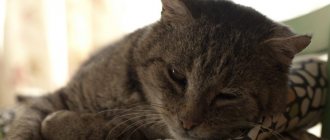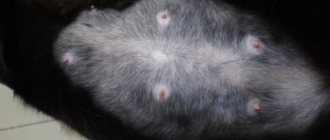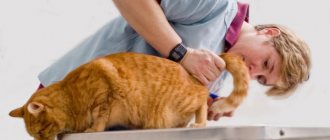Sterilization of cats is a surgical procedure that involves the removal of reproductive organs, which leads to loss of reproductive function and the cessation of external manifestations of sexual desire. Such a radical procedure is often resorted to by owners of domestic cats who do not want to bother with their offspring.
Sterilization is carried out by experienced doctors in a veterinary clinic. After such a procedure, the animal must be properly cared for, which will eliminate possible postoperative complications.
In the article we will talk about the features of caring for a cat after sterilization, how to treat sutures, when to remove the blanket, how to feed it properly, when you can drink water, after how many days the animal can be washed, why a cat should not jump, and what else is unacceptable to do after surgery.
Inpatient care
Preparing a cat for sterilization and proper care for it in the postoperative period are the main conditions that must be observed with special care. They allow the operation to be carried out safely, and also speed up the recovery period of the animal.
The animal can remain in the hospital after surgery for 1 to 10 days, this helps prevent possible complications and also greatly alleviates the cat’s condition.
It is worth highlighting several positive qualities of being in a hospital after sterilization:
- If the animal is kept in the clinic for 24 hours, there will be no need to transport it in the first hours after surgery. At this time, it cannot independently control the temperature;
- If the cat is left in the clinic for up to 5 days, then the veterinary institution will give it all the necessary procedures and injections. Typically, the operated animal is given injections with painkillers for up to three days, tests are taken, and the general condition is monitored. Veterinarians advise using this option for those who cannot independently monitor their pet’s condition at home in the first days after sterilization, and who cannot give injections or remain calm in emergency situations;
- If necessary, the cat can be left in the clinic for 10 days. Of course, this period will be difficult for the pet, because she is not used to being away from home for so long. But at the same time, during this time, specialists will provide full care - they will give injections with painkillers, give the necessary vitamins for the rapid restoration of the animal’s body, and provide a balanced diet;
- If a cat has problems with the heart, as well as with other organs and internal systems, then animal clinics provide special individual care. This is especially true for those pet owners who live far from the clinic. The fact is that if any disease worsens, you may simply not have time to bring the animal to the veterinarian.
Note! Inpatient care for a cat after sterilization also has a significant disadvantage. In these veterinary institutions there is an increased risk of contracting infectious and viral diseases. According to statistics, vaccinations provide protection only in 15-80% of cases.
In addition, when kept in the clinic after surgery, the cat may experience severe stress, and this also negatively affects the recovery process. Anxiety, stress, and anxiety reduce the animal’s immunity. After the clinic, a cat may be offended by the owner for a long time because he abandoned her at a difficult moment, and she may also take revenge on him for this. But the likelihood of this is relatively low, and if proper care is not provided, you can lose the animal.
It is worth contacting trusted clinics with positive reviews. Before you take your pet for sterilization, carefully select a veterinary clinic and specialist who will perform this procedure. The veterinarian must have extensive experience and a positive reputation.
When will the animal completely recover from anesthesia?
The pets finally wake up and feel good after 5 days. If your cat does not drink on the first day after anesthesia, there is no need to worry. You should offer the drink little by little, you can do it from your hand, bringing your palm to the muzzle. You should also do the same to ensure that your pet eats. It is advisable to give soft or dry food, soaked in water. If everything goes without complications, after 7 days the cat is already running and jumping, washing itself, its character and behavior are completely restored. The cat is considered completely healthy after the stitches are removed (7-10 days).
Caring for a cat in the first hours after sterilization
It is advisable to consult with your doctor in advance about the rules for caring for your cat after surgery. Many owners do not know how to behave with their pet after this procedure and can simply cause serious harm to the cat’s health. For this reason, it is better to find out everything right away.
It is worth monitoring your pet especially carefully for 2-3 hours after surgery. The cat should not be left at home alone, without the supervision of a veterinarian, during the period of recovery from anesthesia. She should be at rest after the anesthesia because sudden movements can cause her serious discomfort.
Please note the mandatory rules for caring for your cat after recovery from anesthesia:
- Discharge from the veterinary clinic. In some institutions, the cat is taken out of anesthesia, while in others the animal may be discharged in a state of sleep. It is best to first clarify further care steps when the pet begins to wake up;
- Using a warm blanket to warm up. During the period of recovery from anesthesia after sterilization, the cat cannot independently regulate its body temperature. It is advisable to cover the animal with a warm blanket when transporting it. It is not recommended to use a heating pad yourself, because it can cause severe bleeding;
- After returning home, the pet must be placed on the floor, which is covered with warm material. There should be no drafts in the room;
- If your pet shows signs of pain, she may require pain relief. Cat injections must be given by a veterinarian.
How to treat the seam?
The following compositions can be used to treat a postoperative wound and the tissue around it:
- Miramistin.
- You can treat the seam with chlorhexidine. It is even preferable to the previous option, since the composition has a better antiseptic effect.
- The skin around the seam can be treated with regular alcohol tincture of iodine and brilliant green. The main thing is not to pour these compounds into the wound channel!
- The surface of the seam can and should be treated with levomekol. This is an ointment with a pronounced bactericidal effect. In addition, the composition of dense consistency prevents debris and microflora from entering the wound channel.
Transportation after surgery
Particular attention should be paid to the process of transporting the cat after surgery. This process must be carried out correctly, taking into account all the necessary rules and recommendations. It is worth considering that at this time the animal is experiencing a process of recovery from anesthesia; it can proceed differently for everyone.
Important! The recovery of cats from anesthesia after sterilization may depend on various factors - the characteristics of individual intolerance to the drug, dosage of the drug, compliance with preparations before surgery, and much more.
It is not recommended to transport a cat in your arms or on a car seat. Due to the fact that the animal is under the influence of a narcotic drug at this time, for this reason it may behave unpredictably.
Transportation must be carried out in compliance with the following recommendations:
- as soon as the cat is handed over to the owner after the operation, it must be placed in a special carrier;
- sterilization of a cat must be carried out under anesthesia, so after the operation the pet may be in a state of narcotic sleep or it may begin to slowly wake up from it. For this reason, she must be handled carefully so that she does not get scared;
- For transportation, you should use a spacious carrier, preferably one that has a folding top;
- You should lay a waterproof oilcloth on the bottom surface, and cover the top with a clean sheet.
Anesthesia in a pet causes a decrease in the body's protective properties, for this reason it may lose the ability to normal thermoregulation. For this reason, the animal must be provided with warmth during this period. This requirement is relevant for the winter season, because during this period the risk of hypothermia of the animal’s body is increased.
Warming up your pet can be done according to the following scheme:
- for warming up, you should use a heating pad or a plastic bottle with warm liquid;
- you need to place the object for warming up from the back;
- when warming up, you should strictly ensure that the heating pad or bottle is not on the cat’s crotch area;
- do not allow heat to enter the area with the wound, as it can cause severe bleeding;
- The animal should be covered with a warm blanket on top;
- Constantly monitor the process, do not allow overheating.
Feeding a sterilized pet
It is not recommended to feed your pet in the first hours after anesthesia. After sterilization, many people experience impaired swallowing reflex, which makes eating difficult. During this period, food can cause vomiting, so at first some cats have to be given water from a pipette. The first meal should not exceed 50% of the usual norm.
On the 3-4th day the pet begins to eat fully. After sterilization, the cat's diet should be reviewed to avoid obesity. Therefore, the diet of such an animal should consist of meat, fermented milk products, the fat content of which does not exceed 5%, rolled oats, rice porridge, as well as fruits and vegetables.
For sterilized cats, veterinarians advise purchasing special food. The nutritional value of the product and calorie content are balanced in them. This feeding will give your pet the necessary energy and help maintain health for many years.
Home care
As soon as the animal is at home, it is important to provide him with complete care, which will greatly alleviate the pet’s condition.
It is worth noting! Once the cat is home, it can be left in a carrier or placed on a warm blanket or bedding. The room temperature should be maintained at 22-24 degrees Celsius.
In addition, take important additional measures in the postoperative period:
- You should not immediately place the sterilized cat near the radiator or heaters immediately after sterilization;
- there should be no drafts in the room in which the pet is located;
- After the anesthesia begins to wear off, you should not place the animal on a hill. At this time, it cannot control its movements, the cat may fall and be injured;
- While the cat is sleeping, it is worth placing it on its right side. At this time, her gag reflex may be triggered, and if she lies in the wrong position, she may choke on vomit. But if you prepare correctly, namely following a fasting diet for 12 hours before surgery, then the cat will not vomit; this position will also reduce the load on the heart
- During anesthesia, cats' eyes do not close. As a result, the cornea of the eyes may dry out. It is necessary to close the pet’s visual organs once every half hour; you can also gently massage the eyeballs;
- the use of painkillers provokes severe thirst in the animal. When the cat finally recovers from anesthesia and its movements are already confident, you should place a cup of water nearby.
Mistakes of inexperienced owners
Here is a list of critical mistakes that inexperienced breeders most often make:
- “Filling” the seams with an alcohol tincture of iodine or brilliant green. First of all, it hurts. Secondly, such a concentration of antiseptic compounds does not lead to anything good. More precisely, they simply burn the tissue, which is why a chemical burn also develops right at the postoperative suture, in addition to other “joys”. Accordingly, the regeneration time increases significantly.
- Owners who believe that the seam (provided it looks good) does not need to be processed at all are also mistaken. Like, “it will heal like that.” We must not forget that the environment is rarely sterile, and therefore the wound canal can be contaminated with pathogenic or conditionally pathogenic microflora at any time. This phenomenon will certainly lead to the development of purulent inflammation.
- Some breeders vigorously rub the seam during processing, which is also unacceptable. Rough processing can, firstly, introduce an infection into the seam, and secondly, such actions slow down the regeneration process.
- You cannot thickly coat the seams with ointments, you cannot “tightly” cover it with tight bandages. There must be air access to the wound channel! Otherwise, anaerobic infections may develop, which are fatal to the health of the animal (and often lead to death).
Seam processing
Checking the condition of the seams and caring for them will help avoid various complications. You must ensure that they are always dry and clean. The discrepancy between the edges should not be more than 1 mm.
Important! If you find suppuration and bloody discharge in your pet in the area of the sutures, immediately contact a veterinarian.
If the cat does not experience complications and the healing process proceeds normally, then complete normalization of the animal’s body functions occurs in about two weeks. In this case, the healing period of the suture may depend on the individual characteristics of the representative of the cat family, on the qualifications of the doctor, and on the observance of proper care after surgery.
Many owners often have a question: is it necessary to remove sutures? If self-absorbing threads are used, they will not need to be removed. They will fall off on their own over time when the seam is completely healed. If ordinary material is used, then removal of the sutures after sterilization of the cat is performed only by a veterinary specialist. Removal is usually done 7 to 10 days after sterilization.
To treat the seam, you need to use the following preparations:
- Chlorhexidine and Dioxidine. Solutions with an antiseptic effect are applied to the wound using a pipette;
- Levomekol. The ointment should be used to treat the area around the wound. After treatment, a bandage must be applied;
- It is imperative to use sprays - Aluminum, Chemisprey, Veteritsin - once a day. The drugs are used until complete healing.
Find out more about caring for your cat's sutures after sterilization.
What are the possible postoperative complications?
You should consult a doctor if you experience the following symptoms:
- low temperature (below 37 °C) on the second day after surgery;
- bleeding from stitches and vulva;
- temperature rise above 39 °C;
- hyperemia, rotting, swelling of the sutures on the 6th day;
- the formation of a lump in the area of the seams.
Complications include fever above 39 °C
Do's, Don'ts and Don'ts
The owner of a cat is often lost and does not always understand what is allowed and what is prohibited.
Can
The animal is not sick, but a minor operation, only a temporary deterioration in health.
- take your pet in your arms (do not put pressure on the stomach, picking it up under the hind and front paws);
- take him for short walks;
- give water without restrictions;
- provide food for sterilized cats.
Attention and moderate activity speed up rehabilitation.
Need to
To prevent possible complications it is necessary:
- keep the blanket clean;
- treat the postoperative wound daily;
- control the amount of food eaten (sterilized animals are prone to obesity).
It is necessary to take care of the eyes and ears, treat the fur from parasites, and remove tangles.
Painkillers
A neutered cat may experience pain in the first couple of days, so pain medication should be given. Aggressiveness, refusal to eat, dilated pupils, immobility - these are just a few signs that your pet is in pain. You can help the animal by giving analgesics:
- Previcox;
- Ainil;
- Loxicom;
- Ketoprofen.
There are other medications, give your cat whatever the vet says. Very rarely, animals are given No-Shpu and Analgin, and Paracetamol is simply dangerous for the pet’s life . The dose must be prescribed by the veterinarian who performed the operation.
Those who do not know how or are afraid to give an injection need to take a partial dose of painkiller orally. When an hour has passed, you can already process the seam.
© shutterstock
Using a protective blanket and collar
A blanket is a special cotton garment that has cutouts for the paws and is fastened on the animal's back with Velcro or ties. They wear such a vest from the moment of sterilization until the wound heals.
A protective blanket is necessary to isolate the surgical site from sources of infection.
The collar is attached to the neck and limits the cat's movements towards the body. She will not be able to lick herself and touch the wound.
General information about the procedure
Sterilization is an operation that results in the removal of the uterus and ovaries in females and testes in males. It would be more correct to call the procedure castration, however, to soften the perception of owners, the concept was replaced by the term sterilization. As you know, a fairly large number of owners vehemently oppose the sterilization of pets, but they are guided mainly by common myths.
Let's figure out what changes in the animal's behavior to expect immediately after surgery and after a long period of time. As part of the questions, it is worth touching on the myths that frighten inexperienced owners and make them refuse to castrate their pets.
This is an abdominal operation that is performed under general anesthesia. In large, modern veterinary clinics, the procedure is performed laparoscopically. The advantages of the laparoscopic method are that there is no suture; the uterus and ovaries are removed through two small punctures in the peritoneum. Since laparoscopic surgery is considered expensive, most owners opt for strip surgery.
To avoid serious complications, before sterilization, it is recommended that the cat be examined for heart, kidney and liver failure. Serious complications can be caused by immunodeficiency, exhaustion, dehydration and other disorders leading to suppressed immunity or slowed metabolism.
Note! A common British cat breed, it is considered prone to congenital cardiomyopathy. Before castration of purebred animals, it is strongly recommended to take a blood test and conduct an ultrasound examination of the heart.










